G'day All,
My galvanised steel external flue or stovepipe has a couple of rust patches and what appears to be a white condensate from the burn gases and/or smoke on it.
Some pics below . . .
I was wondering if the condensate, which appears to be worse around the rusted area, has caused or accelerated the rusting? Or is it just a co-incidence that the the condensate is heaviest around the rust?
I was also wondering what the condensate was? It is a white, hard, powdery coating - is the gal coating of the steel flue reacting to something? Or is it just the breakdown of galvanised steel under normal outdoor conditions? Seems strange that only some part of the flue is coated whilst the rest is fine.
I was planning on pulling it apart and cleaning it, then painting it and putting it back. Would a cold gal paint be best? Can they handle the heat? From inside the roof space to the top cap I am using a 6" stainless steel active flue inside the 10" gal exterior flue pipe that is corroding. Whatever that condensate is, will cold gal paint handle the chemical corrosive properties of the condensate? Is there a special kind of exterior flue paint I should obtain that can handle all this - the heat variations and temps, the usual outdoor UV and weather, plus the condensate?
Whenever I have checked my flue during burning - which is quite often, to admire the smokeless heat haze and good draft - it appears to be drafting very well, so I am surprised that I even have such condensate around my flue. Unless, as mentioned before, it is just the gal breaking down. Can anyone clue me in and give me advice on what to do?
Thanks in advance!
My galvanised steel external flue or stovepipe has a couple of rust patches and what appears to be a white condensate from the burn gases and/or smoke on it.
Some pics below . . .
I was wondering if the condensate, which appears to be worse around the rusted area, has caused or accelerated the rusting? Or is it just a co-incidence that the the condensate is heaviest around the rust?
I was also wondering what the condensate was? It is a white, hard, powdery coating - is the gal coating of the steel flue reacting to something? Or is it just the breakdown of galvanised steel under normal outdoor conditions? Seems strange that only some part of the flue is coated whilst the rest is fine.
I was planning on pulling it apart and cleaning it, then painting it and putting it back. Would a cold gal paint be best? Can they handle the heat? From inside the roof space to the top cap I am using a 6" stainless steel active flue inside the 10" gal exterior flue pipe that is corroding. Whatever that condensate is, will cold gal paint handle the chemical corrosive properties of the condensate? Is there a special kind of exterior flue paint I should obtain that can handle all this - the heat variations and temps, the usual outdoor UV and weather, plus the condensate?
Whenever I have checked my flue during burning - which is quite often, to admire the smokeless heat haze and good draft - it appears to be drafting very well, so I am surprised that I even have such condensate around my flue. Unless, as mentioned before, it is just the gal breaking down. Can anyone clue me in and give me advice on what to do?
Thanks in advance!



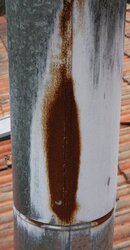

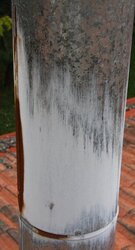
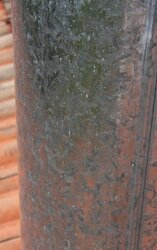
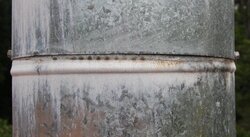
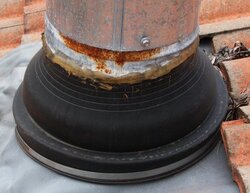
 In reply:
In reply: